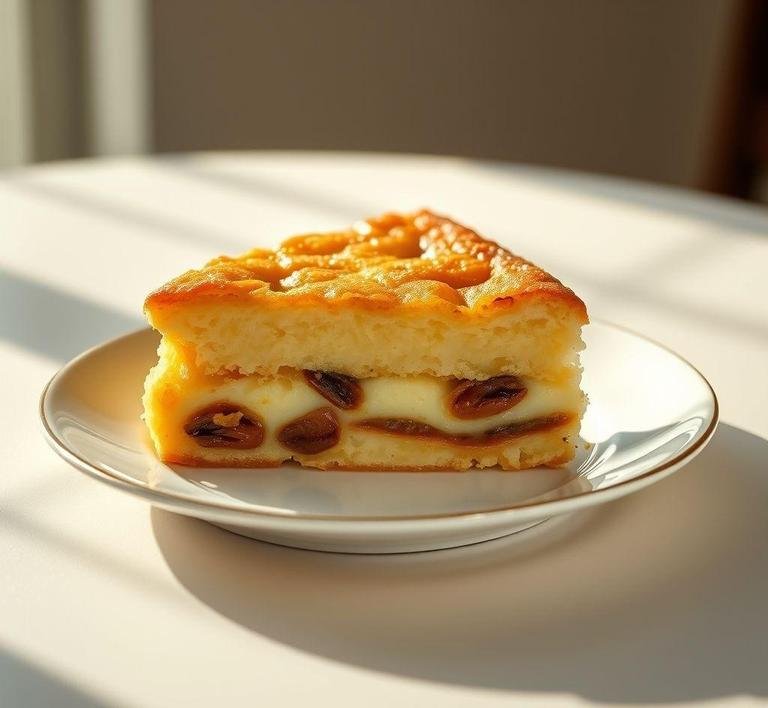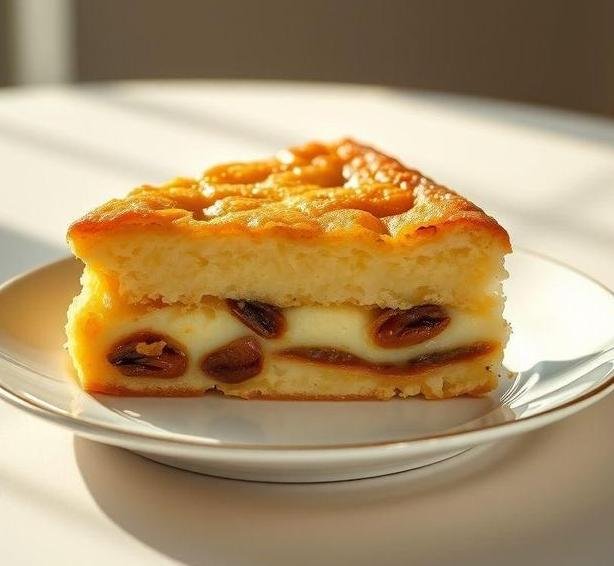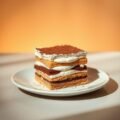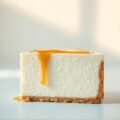Mary Berry’s Bread and Butter Pudding is a classic British dessert that has captured the hearts of many with its comforting, nostalgic qualities. Known for her straightforward approach to baking, Mary Berry has perfected this recipe, elevating it from a simple dish to a delightful treat that combines the textures of soft, custardy layers with the sweet richness of buttered bread. Bread and Butter Pudding is traditionally made from slices of stale bread (often white or brioche), buttered generously, and layered in a baking dish. The bread is then soaked in a creamy custard made from milk, eggs, sugar, and vanilla, before being baked until golden and slightly crispy on top.
This pudding is an ingenious way to use up leftover bread, transforming it into a luxurious, indulgent dessert. The combination of the warm custard with the golden, slightly caramelized top, paired with the soft bread beneath, creates a texture that is both satisfying and comforting. While it can be enjoyed on its own, some may serve it with a dollop of whipped cream, a spoonful of jam, or even a scoop of vanilla ice cream to further enhance the indulgence.
Mary Berry’s Bread And Butter Pudding Recipe
Ingredients Needed

To make Mary Berry’s Bread and Butter Pudding, the following ingredients are essential:
- 6 slices of bread – The bread should ideally be slightly stale, which helps it absorb the custard without becoming too soggy. White bread, brioche, or even challah are popular choices for this pudding, but you can experiment with different types depending on your preferences.
- 75g butter – This is used to generously butter the slices of bread. The butter not only enhances the flavor but also helps to create a deliciously rich, crispy top when the pudding is baked.
- 450ml milk – Full-fat milk is preferred for the custard, as it creates a creamy, rich texture, but you can use semi-skimmed or plant-based alternatives if necessary.
- 2 large eggs – Eggs are what bind the custard together, giving it that classic smooth, velvety texture.
- 75g caster sugar – This adds sweetness to the custard. Caster sugar is ideal because it dissolves quickly into the milk and eggs.
- 1 teaspoon vanilla extract – This adds a subtle, aromatic flavor to the pudding, complementing the richness of the butter and custard.
- Raisin or sultanas (optional) – Some variations of this recipe include dried fruit like raisins or sultanas, which add a touch of sweetness and texture to the pudding.
- Ground nutmeg or cinnamon (optional) – A sprinkle of either spice on top of the pudding before baking adds a wonderful warm, aromatic flavor, though it’s not essential.
- A pinch of salt – A little bit of salt balances the sweetness of the custard and enhances the overall flavor.
Equipment Needed
Mary Berry’s Bread and Butter Pudding requires minimal equipment, making it a straightforward dessert to prepare. Here’s what you’ll need:
- Baking dish – A medium-sized ovenproof dish, around 20cm by 20cm, is ideal for this recipe. You’ll layer the bread in the dish, so it should be deep enough to allow the custard to soak into the bread. A Pyrex or ceramic dish works well.
- Mixing bowl – A large mixing bowl is needed to whisk together the custard mixture, which includes milk, eggs, sugar, and vanilla.
- Whisk – A balloon whisk is perfect for mixing the eggs and milk, ensuring everything is evenly combined.
- Sharp knife – You’ll need a sharp knife to slice the bread. Aim for around 1.5 cm thick slices.
- Measuring spoons and cups – For accuracy when measuring the ingredients like sugar, vanilla, and spices.
- Oven – Of course, an oven is required to bake the pudding. Preheat it to 180°C (fan oven) or 190°C (conventional oven) before starting.
Instructions To Make Mary Berry’s Bread And Butter Pudding
Making Mary Berry’s Bread and Butter Pudding is relatively simple, and the steps are easy to follow. Here’s how to prepare this delightful dessert:
- Preheat the oven – Start by preheating your oven to 180°C (fan oven) or 190°C (conventional oven). Grease your baking dish with a little butter to prevent the pudding from sticking.
- Prepare the bread – Slice the bread into approximately 1.5 cm thick slices. Butter each slice generously on one side with the softened butter. Once buttered, cut the slices in half diagonally to form triangles, which will make a more attractive presentation in the dish.
- Layer the bread in the dish – Arrange the buttered bread slices in the prepared baking dish, overlapping them slightly to cover the bottom evenly. You can add raisins or sultanas between the layers if desired for a burst of fruity flavor.
- Make the custard – In a separate mixing bowl, whisk together the eggs, milk, sugar, and vanilla extract until the mixture is smooth and well-combined. If you’re using a pinch of salt, add it at this stage. You can also sprinkle a little nutmeg or cinnamon into the custard mixture for extra flavor if you wish.
- Pour the custard over the bread – Slowly pour the custard mixture over the bread slices, ensuring that each piece is well soaked. Allow the bread to soak for 10-15 minutes to absorb the custard. If you want a more custardy texture, you can let it sit longer.
- Bake the pudding – Place the baking dish in the preheated oven and bake for 30-40 minutes, or until the top is golden and slightly crispy. The custard should be set but still soft in the center. You can check by inserting a knife into the center – it should come out clean when the pudding is ready.
- Serve and enjoy – Once baked, allow the pudding to cool slightly before serving. It can be enjoyed warm on its own or with a side of whipped cream, custard, or ice cream for an extra indulgence.
Tips And Tricks
- Use stale bread – For the best texture and flavor, make sure to use stale bread. Fresh bread may become too soggy, while stale bread soaks up the custard better, creating that perfect contrast between soft custard and a crispy top.
- Experiment with flavors – Don’t be afraid to get creative! You can swap the vanilla for almond extract for a more nutty flavor, or add some lemon zest to the custard for a citrusy twist.
- Add different dried fruits – Raisins and sultanas are traditional, but feel free to mix things up by adding currants, dried cranberries, or even chopped dried apricots for variety.
- Ensure even soaking – To make sure the bread is evenly soaked in the custard, gently press the bread down with the back of a spoon after pouring the custard over it.
- Bake until golden – For the perfect balance of soft and crispy, don’t rush the baking. A golden top with a slight crisp will add texture, but be careful not to overbake it, as the custard can curdle if it gets too hot.
- Use different breads – Brioche, challah, or even whole grain bread can be used instead of white bread for a different texture and flavor. Brioche, for instance, will give the pudding a more luxurious, buttery flavor.
Mary Berry’s Bread and Butter Pudding is a timeless dessert that combines simplicity with elegance. It’s the kind of dish that not only tastes comforting but also evokes a sense of warmth and nostalgia, making it perfect for family gatherings, holidays, or a cozy evening treat. The beauty of this dessert lies in its versatility – you can stick to the classic recipe or tailor it to your tastes with different breads, spices, or dried fruits.
Easy Recipe Variations For Mary Berry’s Bread And Butter Pudding

Mary Berry’s Bread and Butter Pudding is a quintessentially British dessert-comforting, simple, and perfectly nostalgic. However, there’s no reason you can’t get a little creative with it! Here are some easy recipe variations that can put a fresh spin on this classic.
1. Fruity Twist:
One of the most popular ways to elevate bread and butter pudding is by adding fruit. While traditional recipes often feature raisins or currants, you can experiment with a wider variety of fruits. Try adding juicy, ripe strawberries, blackberries, or sliced bananas for a delicious fruity note. The natural sweetness of these fruits will meld beautifully with the custard, making each bite a burst of flavor.
If you’re feeling adventurous, you could also add dried fruits such as apricots, cranberries, or sultanas for added texture and sweetness. For a tropical flair, try incorporating pineapple or mango chunks-these fruits will add a vibrant splash of color and a sweet, tangy contrast to the richness of the custard.
2. Chocolate Lover’s Delight:
For all the chocolate enthusiasts out there, this is an easy yet indulgent variation. Add a generous sprinkling of dark chocolate chips, milk chocolate chunks, or even swirls of Nutella between the layers of buttered bread. As the pudding bakes, the chocolate will melt into the custard, creating pockets of molten chocolate goodness. You can also drizzle some melted chocolate on top of the pudding after it comes out of the oven for an extra rich finish.
3. Citrus Zest:
A little zest can go a long way in enhancing the flavor profile of bread and butter pudding. Adding grated orange or lemon zest to the custard mixture imparts a light, zesty fragrance that cuts through the richness of the butter and custard. You could also add a splash of lemon or orange juice to the custard base for an extra citrus punch. The result is a fresh, bright contrast to the dish’s traditionally dense, comforting textures.
4. Spiced Variation:
For a spiced-up version, add ground cinnamon, nutmeg, or even cardamom to the custard mixture. These spices evoke warmth and coziness, turning the bread and butter pudding into a perfect dish for fall or winter. A pinch of ground ginger would also work beautifully, adding a bit of zing to the dessert.
5. Nutty Addition:
If you love the crunch and flavor of nuts, consider folding in chopped almonds, pecans, or hazelnuts into the custard mixture or sprinkling them between the layers of bread. The nuts will provide a satisfying contrast to the soft, custard-soaked bread and lend an extra layer of texture and flavor to the pudding.
6. Vegan or Dairy-Free Version:
For those with dietary restrictions, you can still enjoy a delightful bread and butter pudding. Swap out the butter for a plant-based alternative (like margarine or coconut oil) and use dairy-free milk (such as almond or oat milk). You can even try substituting eggs with a mixture of ground flaxseeds and water or a store-bought egg replacer. The result is a vegan-friendly version that still delivers the same comforting vibes.
Storing Leftovers
Storing leftover Bread and Butter Pudding can be a bit tricky since this dessert is best enjoyed fresh out of the oven, with its warm custard and crispy top. However, when you find yourself with some leftover pudding, don’t worry! You can store it and enjoy it again with just a little bit of effort.
1. How To Store
Allow the pudding to cool completely before storing it. This is important to prevent excess condensation from forming, which could make the pudding soggy. Once cooled, cover the pudding with a layer of plastic wrap or store it in an airtight container. Keep it in the fridge for up to 3 days.
2. How To Reheat
To reheat your bread and butter pudding, it’s best to use the oven to maintain its texture. Preheat your oven to 160°C (320°F), cover the pudding with foil to prevent the top from burning, and bake it for around 15-20 minutes, or until it’s heated through. If you prefer a crispy top, you can remove the foil in the last 5 minutes of reheating.
Alternatively, you can microwave individual servings for a quicker fix. Place the portion in a microwave-safe dish, cover with a damp paper towel, and heat for 30-second intervals until warm. The top won’t be as crispy, but it’s still an effective way to enjoy the leftovers.
3. Freezing Leftovers
If you’ve made a large batch of bread and butter pudding or simply want to preserve it for longer, freezing is an option. Cut the pudding into individual portions, and wrap each piece tightly in plastic wrap or foil. Store the wrapped portions in a resealable plastic bag or airtight container. The pudding can be frozen for up to 3 months. To reheat, allow it to thaw in the fridge overnight, then follow the oven reheating instructions above.
Note: Freezing can slightly affect the texture of the bread, so it may not be as light and fluffy once reheated. However, it’s still delicious and an excellent option for those times when you need to store extra servings.
What To Eat With Mary Berry’s Bread And Butter Pudding?
While Mary Berry’s Bread and Butter Pudding is often indulgent enough to be enjoyed on its own, it pairs beautifully with a variety of accompaniments that enhance its creamy, rich texture and sweet flavor. Here are a few ideas:
1. Custard:
The classic pairing! A generous pour of warm, thick custard over your bread and butter pudding is a comforting combination that never fails. The custard complements the pudding’s creamy texture and adds a silky richness that makes every bite decadent.
2. Fresh Fruit:
To balance the richness of the pudding, fresh fruit provides a vibrant, refreshing contrast. Sliced strawberries, raspberries, or a handful of blackberries add a burst of juiciness. You could even toss in some citrus segments (like orange or grapefruit) to bring a zesty punch to each spoonful.
3. Ice Cream or Whipped Cream:
For an even more indulgent treat, serve the bread and butter pudding with a scoop of vanilla ice cream or a dollop of freshly whipped cream. The cold, smooth texture of the ice cream pairs wonderfully with the warm, soft pudding. For a more sophisticated touch, try adding a flavored ice cream, such as cinnamon or caramel.
4. Compote or Jam:
A fruit compote, such as raspberry or mixed berry, can add a tart sweetness that complements the pudding. A spoonful of strawberry or apricot jam could also provide a similar contrast and add another layer of flavor to the dessert.
5. A Cup of Tea or Coffee:
A nice cup of tea-whether it’s a traditional British Earl Grey, Assam, or a soothing herbal variety-can be the perfect drink to serve with your pudding. The subtle bitterness of tea balances out the sweetness of the dessert. Alternatively, if you’re a coffee lover, a creamy cappuccino or a rich espresso can create a wonderful pairing.
Conclusion
Mary Berry’s Bread and Butter Pudding is a timeless dessert that exudes comfort, nostalgia, and warmth with each bite. Its simplicity is part of what makes it so delightful, yet there’s so much room for customization to suit different tastes. Whether you’re adding fruit, chocolate, or spices, the variations are endless, allowing you to create a version that fits your personal preferences.
Storing leftovers is easy, too, so you can enjoy this comforting dessert over multiple days or even freeze it for a rainy day. And when it comes to what to pair it with, a cup of tea, some fresh fruit, or a scoop of ice cream will complement the pudding perfectly. Whether you’re serving it for a family gathering, a cozy weekend treat, or simply because you’ve got a craving for something sweet, Mary Berry’s Bread and Butter Pudding is always a winner.
FAQs
What Ingredients Are Needed For Mary Berry’s Bread And Butter Pudding?
Mary Berry’s bread and butter pudding requires simple and easily accessible ingredients. You’ll need 8 slices of white bread (preferably slightly stale), butter for spreading, 4 large eggs, 600ml of whole milk, 100g caster sugar, 1 tsp vanilla extract, and a pinch of ground nutmeg. Optionally, you can add raisins or sultanas for extra sweetness, and for a golden finish, a dusting of demerara sugar can be sprinkled on top.
How Long Should I Bake Mary Berry’s Bread And Butter Pudding?
Mary Berry recommends baking the bread and butter pudding in a preheated oven at 180°C (fan 160°C) or 350°F for about 40-45 minutes. The pudding should be golden brown on top and slightly puffed. A skewer inserted into the center should come out clean to indicate that it’s fully cooked. Keep an eye on it toward the end of the baking time to avoid over-browning.
Can I Make Mary Berry’s Bread And Butter Pudding Ahead Of Time?
Yes, you can prepare Mary Berry’s bread and butter pudding ahead of time. Simply assemble the pudding, cover it with cling film, and refrigerate it for up to 24 hours before baking. This allows the bread to absorb the custard mixture, resulting in an even richer flavor. When you’re ready to bake, just pop it in the oven as usual, adjusting the baking time slightly if needed.


